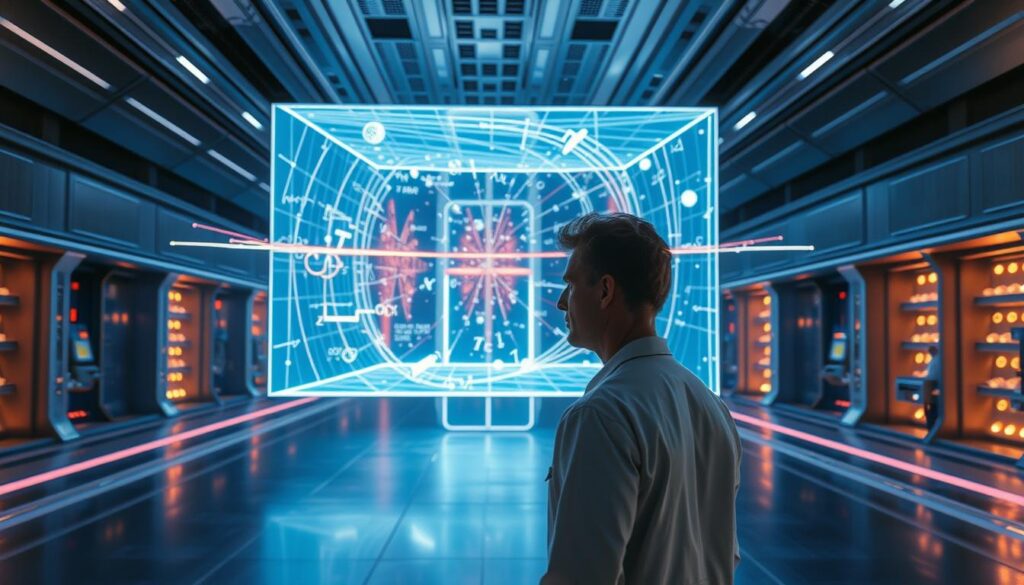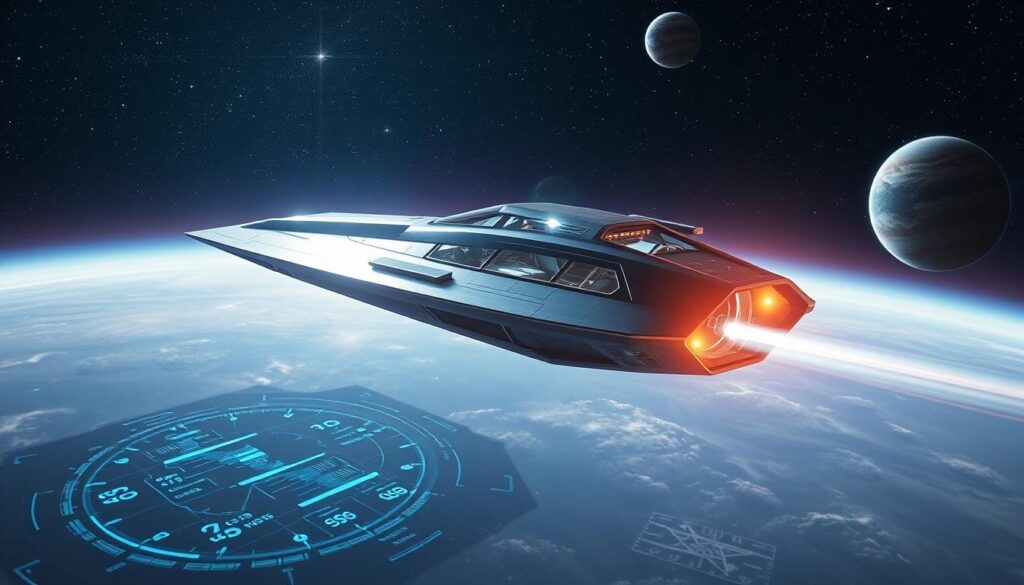Imagine a clock that ticks slower as it moves faster. This isn’t just science fiction—it’s real, thanks to Einstein’s theory of relativity. When objects zip near light speed, time acts strangely, unlike what we’re used to. This phenomenon makes us question our understanding of time.
It creates situations where two people might see time differently. This effect is key in space missions and satellite tech, shaping our science today.
The paradox of time dilation raises a question: If time isn’t the same for everyone, how do we measure it? This article dives into the science behind this mind-bending concept. We’ll start with Einstein’s work and see how speed and gravity affect time. We’ll also look at why this matters for space travel in the future.
Key Takeaways
- Time dilation occurs when relative motion or gravity changes how time passes.
- Einstein’s theories explain why time isn’t absolute but relative to an observer’s speed.
- GPS systems must account for time dilation to function accurately.
- The twin paradox illustrates how time can pass differently for moving vs. stationary observers.
- Understanding this paradox reshapes ideas about space, time, and human travel beyond Earth.
What is Time Dilation?
Time dilation is a key part of modern physics that changes how we see time. It shows that time can move at different speeds for people moving or in different gravity. This is why scientists focus on its consequences of relativistic travel in space and technology.
At its heart, time dilation comes from Einstein’s relativity. Let’s look at its basics and history:
Definition of Time Dilation
Time dilation happens when two people see time differently because of speed or gravity. For example, a clock on a fast-moving spaceship will run slower than one on Earth. This effect is small at slow speeds but gets bigger as you get closer to the speed of light. GPS satellites need to adjust for this to work right, showing how consequences of relativistic travel affect our daily lives.
Historical Context
Important events have shaped our understanding of time dilation. Here are some key moments:
| Year | Event | Impact |
|---|---|---|
| 1887 | Micelson-Morley experiment | Disproved aether theory, prompting Einstein’s work |
| 1905 | Einstein’s Special Relativity | First described time dilation mathematically |
| 1971 | Hafele-Keating experiment | Jet-based atomic clocks confirmed time dilation effects |
These steps laid the groundwork for today’s knowledge. As we move forward, understanding these consequences of relativistic travel is key for exploring space and creating new technologies.
The Theory of Relativity Explained
Albert Einstein introduced special relativity in 1905, changing how we see space and time. It shows time isn’t fixed; it changes with motion. This idea is key to understanding time dilation effects in fast-moving situations.
Einstein’s Special Relativity
Picture two people: one on a fast train, the other standing still. Einstein said they’d see time and space differently. For instance, lightning might seem to strike at the same time for one but not the other. This relativity of simultaneity proves time isn’t the same everywhere, leading to time dilation effects.
Key Concepts in Relativity
Two main rules make up special relativity:
- Speed of light constancy: Light always travels at 299,792 km/s, no matter the observer’s speed.
- Relativity principle: Physical laws are the same in all moving frames. Time moves slower for fast-moving objects compared to slower ones.
These rules blend space and time into a single, four-dimensional fabric called spacetime. When objects get close to light speed, their time stretches. This is what time dilation effects are all about. Experiments with atomic clocks on planes and satellites have proven Einstein right, showing his ideas are science, not just theory.
How Speed Affects Time Perception
Speed isn’t just about how far you go in a certain time. It actually changes how we see time. According to relativity, moving close to light speed makes time seem to slow down for you compared to others. This is called time dilation, and it’s not just a theory. It’s proven in real-life experiments every day.
The Effects of High-Speed Travel
When you move fast, time seems to pass slower for you. For example:
- Particle accelerators show muons—tiny particles—last longer when moving near light speed.
- Airplane experiments with atomic clocks, like the 1971 Hafele-Keating test, showed flight direction and speed altered clock readings slightly.
Examples from Physics Experiments
Astronauts on the International Space Station age a tiny bit slower each year. This is because of Earth’s gravity and their speed in orbit. These small differences show how relativity works in real life.
“The laws of physics are the same for all non-accelerating observers.”
—Albert Einstein, summarizing the foundation of these effects
Even everyday tech like GPS needs to account for these time shifts. Satellites in orbit must adjust their clocks to match those on Earth. This shows that relativity isn’t just a theory. The faster you move, the more time stretches. It’s a real effect, as real as the stars in the sky.
Real-World Consequences of Time Dilation
Imagine astronauts aging a fraction of a second less than people on Earth after a space trip. This isn’t science fiction—it’s the time dilation paradox affecting modern space exploration and technology. These effects require real solutions for rockets and satellites.
Space agencies like NASA plan missions with this phenomenon in mind. The time dilation paradox affects both human biology and equipment. For example, astronauts on the International Space Station (ISS) age 0.005 seconds less each year than people on Earth.
Longer missions, like those to Mars, need precise calculations. This is to track the health of the crew and the mission’s timeline.
Implications for Space Travel
- Astronauts experience measurable time differences after extended spaceflight
- Mission clocks must sync with Earth-based systems for navigation
- Deep-space travel could amplify these effects dramatically
Practical Applications in Technology
GPS systems use atomic clocks adjusted for time dilation paradox effects. Satellites moving at 14,000 km/h experience time passing faster than on Earth. Engineers adjust signals by 38 microseconds daily to keep them accurate.
Without these adjustments, navigation errors would grow by 10 km/day.
| Scenario | Time Difference per Day | Impact |
|---|---|---|
| ISS Astronauts | 0.007 milliseconds | Biomedical tracking |
| GPS Satellites | 38 microseconds | Navigation precision |
| Deep-space probes | Up to 1 second/year | Data transmission timing |
“Time exists in the minds of humans, not in reality.” – Albert Einstein
These corrections are not just theories—they’re daily math keeping global systems working. From smartphones to space probes, humanity navigates a universe where time isn’t fixed.
Twin Paradox: A Thought Experiment
Imagine two twins: one stays on Earth, the other speeds off in a rocket near light-speed. When the traveler returns, they’ve aged far less than their sibling. This scenario, the twin paradox, challenges our intuition about time. At its core, it ties to relativistic time travel, where motion and acceleration warp time’s passage.
“The twin paradox isn’t a flaw in relativity—it’s a window into how spacetime bends under motion.”
What Happens in the Twin Paradox?
The experiment unfolds like this:
- Twin A stays on Earth, in a steady reference frame.
- Twin B rockets into space at 90% light-speed, then returns home.
- Upon return, Twin B is younger than Twin A.
Resolving the Paradox
The “paradox” dissolves when considering acceleration. Twin B’s journey involves thrust to turn around, breaking symmetry between their paths. Acceleration ties Twin B to a non-inertial frame, while Twin A remains inertial. This asymmetry explains’s the age gap. Relativistic time travel thus depends on motion’s direction and acceleration’s role in spacetime geometry.
Experiments with atomic clocks on planes confirm this effect. For instance, jets circling Earth at high speed show minuscule time delays, mirroring the twin paradox on a tiny scale. This proves that relativistic effects aren’t just theory—they’re testable, shaping how we build GPS systems today.
Timekeeping in Different Reference Frames

When objects move at different speeds, their clocks tick at varying rates. This is due to special relativity implications. It shows time isn’t absolute but depends on how fast you’re moving. This knowledge is crucial for scientists to create accurate tools for space missions.
Clocks Moving at Different Speeds
Speed affects how we measure time:
- Clocks on satellites run faster than Earth-bound ones due to orbital speed
- Particles in accelerators decay slower when moving near light speed
- Airplane clocks show nanosecond differences compared to ground clocks
Experiments Confirming Time Dilation
Key tests proving Einstein’s predictions:
| Experiment | Year | Key Finding |
|---|---|---|
| Hafele-Keating | 1971 | Jet clocks confirmed predicted time shifts |
| Muon Decay | 1940s | Fast-moving muons lived longer than expected |
| GPS Satellite Tests | 2000s | Atomic clocks adjusted using relativity formulas |
These tests show special relativity implications are real. They influence modern technology, like GPS systems we use every day.
Time Dilation and Modern Technology
Time dilation is a key part of our daily tech. It keeps GPS systems working and phone calls connected. Let’s see how physics powers our gadgets.
GPS Satellites and Relativistic Adjustments
GPS satellites are 20,000 km above Earth. They face two big effects: speed and gravity. Engineers adjust their clocks to keep them accurate.
Without these adjustments, GPS errors would grow by 10 meters every day.
| Factor | Relativistic Effect | Correction Applied |
|---|---|---|
| Speed (Special Relativity) | Clocks tick 7 microseconds/day slower | Clocks adjusted to run slower |
| Gravity (General Relativity) | Clocks tick 45 microseconds/day faster | Software compensates for gravity’s pull |
| Total daily drift uncorrected | ~38 microseconds/day | Combined adjustments keep errors under 100 nanoseconds |
Impact on Telecommunications
Telecom networks use fiber-optic cables and satellites. Signals travel at light speed, so small delays matter. For example:
- Satellite TV uses relativity-aware clocks to sync broadcasts
- 5G towers account for time differences when routing calls
- Global stock markets depend on precise timing to avoid trading errors
Time dilation keeps our phones connected and maps accurate. Without it, modern tech wouldn’t work right.
Philosophical Implications of Time Dilation
“Time is that which prevents everything from happening at once.” — Henri Bergson
Time dilation makes us question time’s role in our lives. It was once thought of as a constant, but now it seems to change based on how fast we move and where we are. This change sparks big debates: Is time something everyone agrees on, or is it just how we see it? Does our ability to make choices really exist if time seems to move differently for everyone?
How Does This Change Our Understanding of Time?
| Concept | Old View | New Perspective |
|---|---|---|
| Time’s Nature | Fixed and absolute | Relative to motion and gravity |
| Human Perception | Time as a linear path | Time as a flexible dimension |
Philosophers are divided on whether time is something we make up or a real part of the universe. If time can seem to slow down or speed up, can we still talk about right and wrong? These questions mix science and deep thinking about life.
Time Dilation in Popular Culture
- Interstellar (film): 2014): Shows astronauts aging slower near black holes.
- Carl Sagan’s Contact (book): 1985): Looks at how time changes during space travel.
- Star Trek’s Star Date system: Shows how people try to make time work the same everywhere in space.
These stories show our effort to understand time’s flexibility. By mixing science with creativity, they help us see complex ideas in a new way.
Future of Relativistic Travel

Science keeps moving forward, making the dream of visiting distant stars closer. New ways to travel through space are being explored. Relativistic travel is still a dream, but scientists are making progress.
What Does the Future Hold?
Experts think breakthroughs could come from new ways to move things in space. Here’s what they predict:
- Warp drive concepts, like the Alcubierre model, aim to manipulate spacetime itself.
- Advanced nuclear propulsion might cut travel times to Mars and beyond.
- Quantum physics theories could unlock methods to bypass light-speed limits indirectly.
Challenges to Overcoming Light Speed
But there are huge obstacles to overcome. Key challenges include:
- Energy demands for near-light-speed travel are beyond current tech capabilities.
- Time dilation effects could strand crews decades behind Earth time, complicating missions.
- Materials science must develop to withstand cosmic radiation at extreme velocities.
Despite these challenges, curiosity keeps pushing us forward. Every discovery brings us closer to exploring the universe.
Summary and Reflection
As we finish our exploration of time dilation, it’s clear Einstein’s theories change how we see time. They link cosmic ideas to everyday tech. Let’s look back and see why this is important.
Key Takeaways on Time Dilation
Einstein’s relativity shows time isn’t the same for everyone. Speed and gravity can warp it, as atomic clock experiments prove. GPS systems use this knowledge every day, making sure signals are accurate.
The twin paradox, once a mystery, now shows how moving changes time’s flow.
The Significance of Understanding Relativistic Travel
Understanding how spacetime bends opens up new paths for exploration. Engineers use relativity to create tools like GPS satellites. This shows science fiction is closer than we think.
As we aim for Mars or further space, knowing time dilation is key. It makes travel safer and faster. It’s not just a theory; it’s the base of today’s tech and our future beyond Earth.



